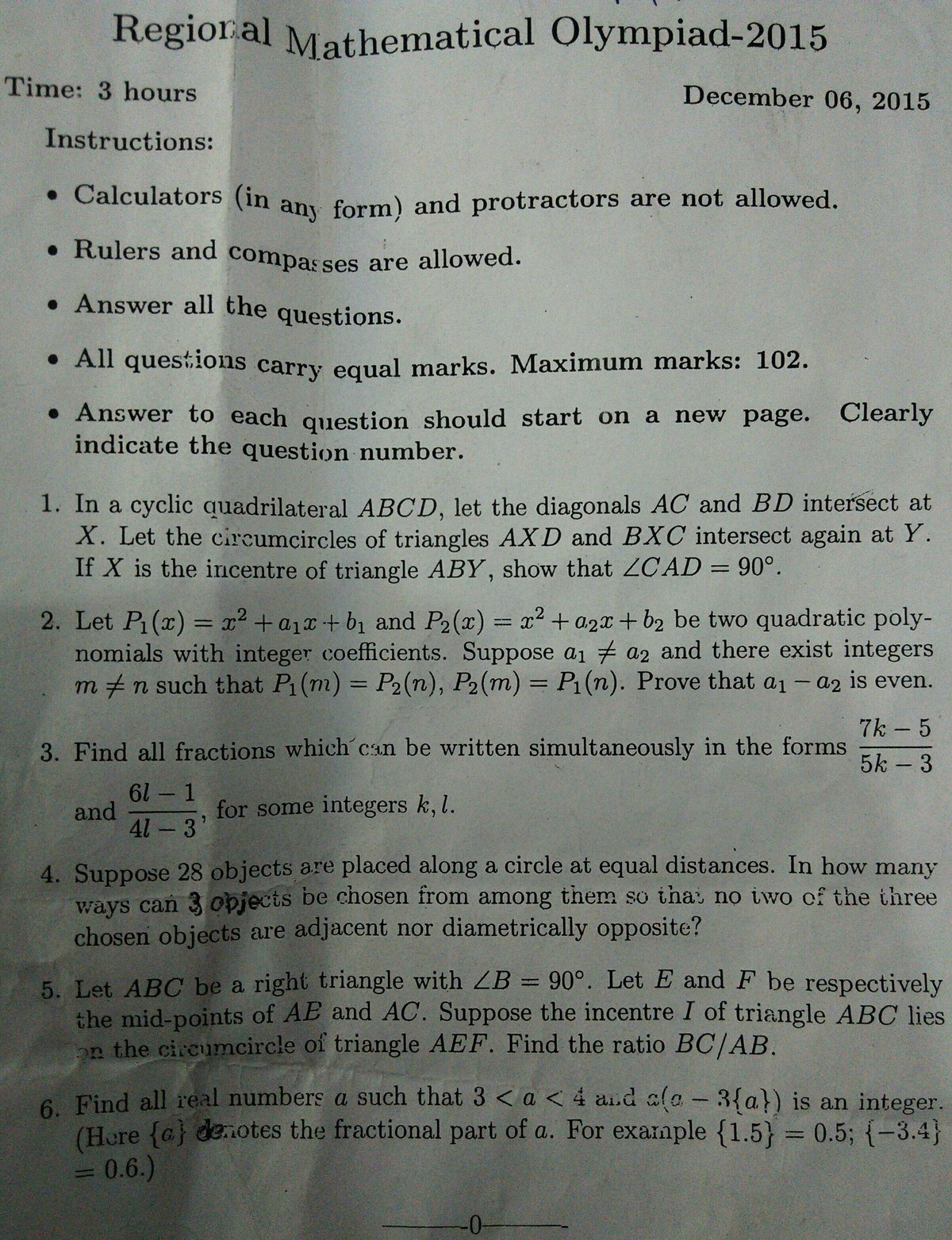CBSE GMO 2015 Paper discussion

Group Mathematical Olympiad is conducted by CBSE . It is only for CBSE students . Every CBSE school can send 5 students for it. Around 30 students are selected from the country and are eligible to write INMO.
No vote yet
1 vote
Easy Math Editor
This discussion board is a place to discuss our Daily Challenges and the math and science related to those challenges. Explanations are more than just a solution — they should explain the steps and thinking strategies that you used to obtain the solution. Comments should further the discussion of math and science.
When posting on Brilliant:
*italics*or_italics_**bold**or__bold__paragraph 1
paragraph 2
[example link](https://brilliant.org)> This is a quote# I indented these lines # 4 spaces, and now they show # up as a code block. print "hello world"\(...\)or\[...\]to ensure proper formatting.2 \times 32^{34}a_{i-1}\frac{2}{3}\sqrt{2}\sum_{i=1}^3\sin \theta\boxed{123}Comments
Answer to question 3. 4l−36l−1=5k−37k−5 After cross multiplication we get 8k+l+lk=6 Adding 8 to both sides 8k+8+l+lk=14 8(k+1)+l(1+k)=14 (8+l)(1+k)=14 Since l,k are integers therefore the solutions of (l,k)=(−1,1),(−6,6),(6,0),(−7,13),(−15,−3),(−22,−2),(−10,−8),(−9,−15) Therefore the required fractions are 1,3143,35,2737,913,1319,4361,3955
Log in to reply
Can anybody please post a proper solution for question 4 with explanation?
Log in to reply
Number of ways of selecting points from points is 28C3=3276
Now, we will eliminate some conditions..
Number of ways of selecting all 3 as adjacent points is 28.
Number of ways of selecting 2 adjacent points and one not adjacent with them is 28×24=672
Number of ways of selecting two points opposite diametrically along with the third point not adjacent to the former points is 14×22=308.
Hence, the desired result will be 3276-28-672-308=2268
1 will be rejected as it isn't a fraction.
Answer to question number 2. P1(m)−P2(n)=a1−a2=m−n2(b2−b1) This implies that a1−a2=even. P1(m)−P2(n)=a1+a2=−2(m+n) This implies that a1+a2=even. Hence proved.
Log in to reply
Shivam dud you gave GMO or RMO?
Log in to reply
RMO
Log in to reply
How many did you solve?
Log in to reply
5
when will the results of gmo will be declared
Can anyone tell the answer of 5th question
Log in to reply
it is 4/3
Log in to reply
I m getting 1/3
Log in to reply
see i can't post my solution because it is too long but you can verify it by construction.
I was able to do 4.5 questions do i stand a chance to get selected...
Is the answer to question 4 2268?
Log in to reply
Yes it is
Log in to reply
Can you tell me what is the expected cutoff for gmo?
Answer to question 6. Let a=m+cb where m is any integer and 0<b<c . Then a(a−3a)=(m+cb)(m−2cb) m2−cbm+c22b2. m2−c22b2−bcm Now, m is an integer . Let's consider c22b2−bcm=k where k is an integer . After solving we get cb=4m+−m2+8k.....(I) But cb<1....(II) Now putting value of cb from (I) to (II). We get m+k<2 Therefore there are infinitely many integers m,k such that m+k<2. Hence proved.
Log in to reply
Bro ur equation which is quadratic in m is wrong also we will get 4 values of a
Log in to reply
A general solution a=(2n+1)+0.5 where n is a integer.
@Shivam Jadhav This ques is a little different from the RMO one , we have to find all values of 'a' between 3 & 4. @Devansh Shah is right , there will be 4 values.
m cant be 'any' integer as 3<a<4. So a will be 3.something or a = 3 + b/c
you can try the 6 question posted by me they all are of gmo.